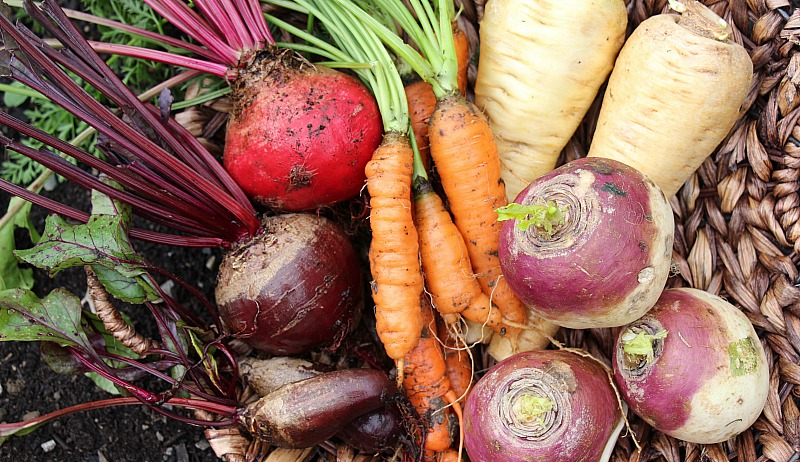
There’s nothing quite like pulling a homegrown carrot from the soil for a Valentine’s Day celebration with your sweetheart. If you’ve never managed this feat, perhaps this will be your year. Overwintering root vegetables is easier than you think, if you employ a successful overwintering strategy.
While many gardeners store harvested root crops in their cold cellars and basements, I store mine in the soil. Instead of pulling and storing carrots, turnips, beets, rutabagas and parsnips at the end of the growing season, I leave them in the ground and harvest individual roots as I need them throughout the winter months. Blessed with incredible insulative properties, the soil is an excellent place for overwintering root vegetables. Because it holds onto summer’s warmth for weeks after the air temperatures drop, root veggies that remain tucked into the ground can be harvested even when temps dip into the minus digits. And, with an added layer of supplemental insulation, your harvest can continue all winter long in all but the coldest of climates.
Here are three ways to see your root crops safely through the winter.
1: Put Them To Bed Under A Thick Layer Of Mulch
One of the easiest ways of overwintering root vegetables is to tuck them under a heavy layer of mulch. After the arrival of fall’s first few frosts, pile five to seven inches of straw or hay on top of them. I keep the straw in place with a couple of 2x4s crossed in an X shape over the top of the straw. If you live where winters get very cold, say Minnesota, this technique probably won’t allow your root crops to survive much past Christmas, but here in Pennsylvania, I’ve successfully been able to overwinter root crops using this method many times. When you want to harvest a few roots, simply lift the blanket of straw (even if it’s frozen) and dig around in the soil beneath.
2: Build A Straw Bale “Topper” Over The Area
This method works best if your root crops are planted in a block, rather than in a row. To overwinter with a “topper,” completely surround the perimeter of the block of root crop plants with straw bales. Then, cover the area in the center of the bales with a layer of floating row cover, allowing it to rest directly on top of the plants with the edges hanging out over the top of the bales. Fill in the area at the center of the bales with a dense layer of shredded leaves or straw, completely covering the floating row cover and the root crops nestled beneath it. I use as many shredded leaves as I can get, but a minimum of eight to 10 inches is best. When you want to harvest, pull aside a straw bale, lift up the edge of the row cover and dig up some roots. When you’re done, move the bale back into place and reposition the row cover topped with shredded leaves or straw. Come spring, the partially decomposed leaves and/or straw can be dumped right onto the garden.
3: Let Compost Heat Your Soil
Another way of overwintering root vegetables in the ground is to heat the bed with a “cooking” compost ring. As you rake up and collect autumn leaves and plant trimmings this fall, instead of tossing them onto your existing compost pile, create a new, movable compost ring right on top of your root crops. To do this, first cover the root crop bed with a large, flat piece of concrete reinforcement wire, making sure the piece is large enough to extend over the edges of the bed by two or three inches in each direction. Then, make a cylinder out of chicken wire or boxwire fencing with a large enough diameter to cover as much of the bed of root crops as possible. The cylinder should be about two to three feet tall. Cover the piece of concrete reinforcement wire with another piece of chicken wire or boxwire fencing, and then place the wire cylinder you made on top. The piece of concrete reinforcement wire at the base is strong enough to allow you to move the pile as needed while the smaller holes of the bottom layer of chicken wire keep the decomposing materials from falling through.
Once in place, fill the cylinder with layers of yard waste, kitchen scraps and fall leaves, just as you would build any other compost pile. Whenever you’d like to harvest the root crops beneath your compost ring, simply grab one side of the concrete reinforcement wire and drag the entire ring to the side. Dig up the roots you need and then drag the compost ring back into place. The heat generated by the decomposing materials is enough to keep the overwintering root vegetables warm and cozy, and it keeps the compost pile and wire from freezing to the ground. Turn the pile every few weeks to keep the pile “cooking” all winter long.
With these three overwintering techniques, you can enjoy your root crops all winter long and save precious cold cellar space for apples, potatoes and winter squash.




